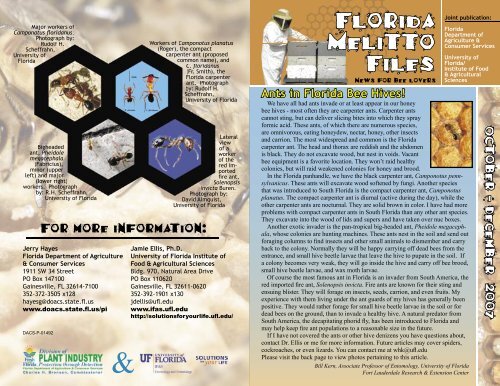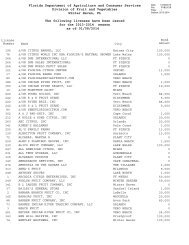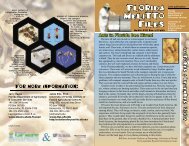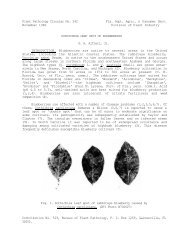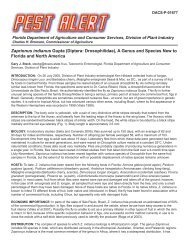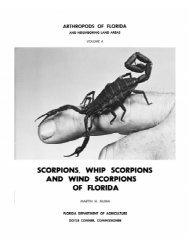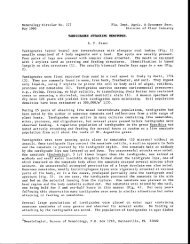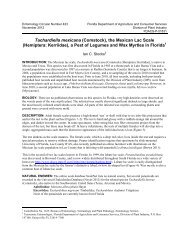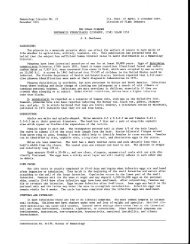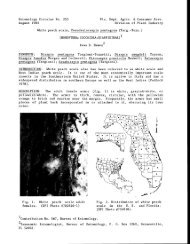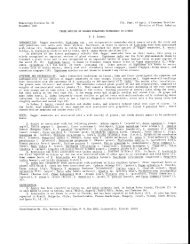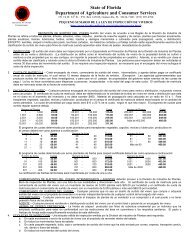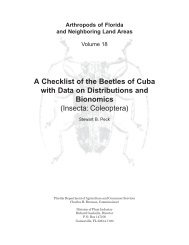Florida Melitto Files - Florida Department of Agriculture and ...
Florida Melitto Files - Florida Department of Agriculture and ...
Florida Melitto Files - Florida Department of Agriculture and ...
You also want an ePaper? Increase the reach of your titles
YUMPU automatically turns print PDFs into web optimized ePapers that Google loves.
Major workers <strong>of</strong><br />
Camponatus fl oridanus.<br />
Photograph by:<br />
Rudolf H.<br />
Scheffrahn,<br />
University <strong>of</strong><br />
<strong>Florida</strong><br />
Bigheaded<br />
ant, Pheidole<br />
megacephala<br />
(Fabricius),<br />
minor (upper<br />
left) <strong>and</strong> major<br />
(lower right)<br />
workers. Photograph<br />
by: R.H. Scheffrahn,<br />
University <strong>of</strong> <strong>Florida</strong><br />
DACS-P-01492<br />
For more information:<br />
Jerry Hayes<br />
<strong>Florida</strong> <strong>Department</strong> <strong>of</strong> <strong>Agriculture</strong><br />
& Consumer Services<br />
1911 SW 34 Street<br />
PO Box 147100<br />
Gainesville, FL 32614-7100<br />
352-372-3505 x128<br />
hayesg@doacs.state.fl .us<br />
www.doacs.state.fl .us/pi<br />
&<br />
Workers <strong>of</strong> Camponotus planatus<br />
(Roger), the compact<br />
carpenter ant (proposed<br />
common name), <strong>and</strong><br />
C. fl oridanus<br />
(Fr. Smith), the<br />
<strong>Florida</strong> carpenter<br />
ant. Photograph<br />
by: Rudolf H.<br />
Scheffrahn,<br />
University <strong>of</strong> <strong>Florida</strong><br />
Lateral<br />
view<br />
<strong>of</strong> a<br />
worker<br />
<strong>of</strong> the<br />
red imported<br />
fi re ant,<br />
Solenopsis<br />
invicta Buren.<br />
Photograph by:<br />
David Almquist,<br />
University <strong>of</strong> <strong>Florida</strong><br />
Jamie Ellis, Ph.D.<br />
University <strong>of</strong> <strong>Florida</strong> Institute <strong>of</strong><br />
Food & Agricultural Sciences<br />
Bldg. 970, Natural Area Drive<br />
PO Box 110620<br />
Gainesville, FL 32611-0620<br />
352-392-1901 x130<br />
jdellis@ufl .edu<br />
www.ifas.ufl .edu<br />
http://solutionsforyourlife.ufl .edu/<br />
<strong>Florida</strong><br />
<strong>Melitto</strong><br />
<strong>Files</strong><br />
News for bee lovers<br />
Ants in <strong>Florida</strong> Bee Hives!<br />
Joint publication:<br />
<strong>Florida</strong><br />
<strong>Department</strong> <strong>of</strong><br />
<strong>Agriculture</strong> &<br />
Consumer Services<br />
University <strong>of</strong><br />
<strong>Florida</strong>/<br />
Institute <strong>of</strong> Food<br />
& Agricultural<br />
Sciences<br />
We have all had ants invade or at least appear in our honey<br />
bee hives - most <strong>of</strong>ten they are carpenter ants. Carpenter ants<br />
cannot sting, but can deliver slicing bites into which they spray<br />
formic acid. These ants, <strong>of</strong> which there are numerous species,<br />
are omnivorous, eating honeydew, nectar, honey, other insects<br />
<strong>and</strong> carrion. The most widespread <strong>and</strong> common is the <strong>Florida</strong><br />
carpenter ant. The head <strong>and</strong> thorax are reddish <strong>and</strong> the abdomen<br />
is black. They do not excavate wood, but nest in voids. Vacant<br />
bee equipment is a favorite location. They won’t raid healthy<br />
colonies, but will raid weakened colonies for honey <strong>and</strong> brood.<br />
In the <strong>Florida</strong> panh<strong>and</strong>le, we have the black carpenter ant, Camponotus pennsylvanicus.<br />
These ants will excavate wood s<strong>of</strong>tened by fungi. Another species<br />
that was introduced to South <strong>Florida</strong> is the compact carpenter ant, Camponotus<br />
planatus. The compact carpenter ant is diurnal (active during the day), while the<br />
other carpenter ants are nocturnal. They are solid brown in color. I have had more<br />
problems with compact carpenter ants in South <strong>Florida</strong> than any other ant species.<br />
They excavate into the wood <strong>of</strong> lids <strong>and</strong> supers <strong>and</strong> have taken over nuc boxes.<br />
Another exotic invader is the pan-tropical big-headed ant, Pheidole megacephala,<br />
whose colonies are hunting machines. These ants nest in the soil <strong>and</strong> send out<br />
foraging columns to fi nd insects <strong>and</strong> other small animals to dismember <strong>and</strong> carry<br />
back to the colony. Normally they will be happy carrying <strong>of</strong>f dead bees from the<br />
entrance, <strong>and</strong> small hive beetle larvae that leave the hive to pupate in the soil. If<br />
a colony becomes very weak, they will go inside the hive <strong>and</strong> carry <strong>of</strong>f bee brood,<br />
small hive beetle larvae, <strong>and</strong> wax moth larvae.<br />
Of course the most famous ant in <strong>Florida</strong> is an invader from South America, the<br />
red imported fi re ant, Solenopsis invicta. Fire ants are known for their sting <strong>and</strong><br />
ensuing blister. They will forage on insects, seeds, carrion, <strong>and</strong> even fruits. My<br />
experience with them living under the ant guards <strong>of</strong> my hives has generally been<br />
positive. They would rather forage for small hive beetle larvae in the soil or for<br />
dead bees on the ground, than to invade a healthy hive. A natural predator from<br />
South America, the decapitating phorid fl y, has been introduced to <strong>Florida</strong> <strong>and</strong><br />
may help keep fi re ant populations to a reasonable size in the future.<br />
If I have not covered the ants or other hive denizens you have questions about,<br />
contact Dr. Ellis or me for more information. Future articles may cover spiders,<br />
cockroaches, or even lizards. You can contact me at whk@ufl .edu<br />
Please visit the back page to view photos pertaining to this article.<br />
Bill Kern, Associate Pr<strong>of</strong>essor <strong>of</strong> Entomology, University <strong>of</strong> <strong>Florida</strong><br />
Fort Lauderdale Research & Extension Center<br />
October - December 2007
FDACS/DPI<br />
FROM THE DESK OF JERRY HAYES FROM THE DESK OF DR. JAMIE ELLIS<br />
In August, I represented the <strong>Florida</strong> <strong>Department</strong> <strong>of</strong><br />
<strong>Agriculture</strong> & Consumer Services, Division <strong>of</strong> Plant<br />
Industry’s apiary section at the North Central (NC) 508<br />
meeting titled, “Sustainable Solutions to Problems Affecting<br />
Honey Bee Health.” There were 25 attendees representing<br />
University Extension; USDA Cooperative State Research,<br />
Education, <strong>and</strong> Extension Service; American Association<br />
<strong>of</strong> Pr<strong>of</strong>essional Apiculturalist; <strong>and</strong>, Apiary Inspectors <strong>of</strong><br />
America. The meeting was designed to share, discuss <strong>and</strong><br />
formalize committee mechanisms for collaborative research<br />
Jerry Hayes, FDACS/DPI <strong>and</strong> funding possibilities to address honey bee health issues<br />
Asst. Chief Apiary Inspection <strong>and</strong> challenges.<br />
Public awareness has been suffi ciently raised, <strong>and</strong> the<br />
government’s attention is focused as at no other time on the devastating loss <strong>of</strong><br />
honey bees <strong>and</strong> other pollinators from the environment. Colony Collapse Disorder<br />
has been the riveting force for global recognition that honey bees are the vital link<br />
in production agriculture <strong>and</strong> the general health <strong>of</strong> the environment. Couple this<br />
raised awareness with the tremendous interest, support <strong>and</strong> political strength from<br />
other pollinator groups such as North American Pollinator Protection Campaign,<br />
Co-Evolution Institute, Monarch Watch, <strong>and</strong> the media, <strong>and</strong> you’ll see it has led to<br />
Congress stepping up to the plate to respond to the public’s dem<strong>and</strong> for a solution.<br />
There is a strong possibility that there will be funding made available through<br />
several pathways such as the Cooperative Agricultural Pest Survey, National<br />
Research Institute, 406 Programs, <strong>and</strong> others. The NC 508 group is preparing to<br />
access funding that becomes available to begin research in honey bee health.<br />
DPI, while not representing pure research or extension activities, was invited<br />
to participate in this meeting as a partner <strong>and</strong> part <strong>of</strong> this community. For any<br />
substantive research to be conducted, fi eld surveys will have to be performed.<br />
Beekeepers <strong>and</strong> apiaries will have to be identifi ed <strong>and</strong> located. Samples will have to<br />
be collected <strong>and</strong> assessments made. DPI’s apiary section was included in this seminal<br />
meeting in hopes that we would consider joining the collaborative effort if <strong>and</strong> when<br />
needed. Honey bee health <strong>and</strong> the health <strong>and</strong> vitality <strong>of</strong> our apiculture industry are<br />
the goals <strong>of</strong> all <strong>of</strong> us regardless <strong>of</strong> what “<strong>of</strong>fi cial” function we provide <strong>and</strong> who we<br />
serve. DPI was at the table, visible <strong>and</strong> willing to respond <strong>and</strong> be responsive within<br />
this community. We will have to see how this evolves, but I appreciate your support<br />
in extending the stride <strong>of</strong> DPI’s apiary section as we work with our colleagues in<br />
research <strong>and</strong> extension in other parts <strong>of</strong> the nation.<br />
The FDACS’ Division <strong>of</strong> Marketing, Bureau <strong>of</strong> Education <strong>and</strong> Communication<br />
has produced a high quality DVD, “Africanized Bees in <strong>Florida</strong>: Coping With The<br />
Challenge.” If you would like to share this video with your local media, please<br />
contact me by e-mail at hayesg@doacs.state.fl .us or phone me at (352) 372-3505 ext<br />
128 to request a copy.<br />
Greetings <strong>Florida</strong> Beekeepers! I hope that the summer<br />
beekeeping season treated you well <strong>and</strong> that your colonies<br />
are strong <strong>and</strong> healthy. My students, technicians, <strong>and</strong> I<br />
remain busy with our research, extension, <strong>and</strong> instruction<br />
efforts. I look forward to discussing our progress with you at<br />
the fall meeting <strong>of</strong> the <strong>Florida</strong> State Beekeepers Association<br />
(see special FSBA insert).<br />
I want to use this quarter’s column to give you a sneak<br />
preview <strong>of</strong> the <strong>Florida</strong> Master Beekeeper Program. Jerry<br />
Hayes (FDACS-DPI), Ray Zerba (extension agent, Clay<br />
Dr. Jamie Ellis<br />
County), Tom Donovan (extension agent, St. Johns County),<br />
UF Asst. Pr<strong>of</strong>essor<br />
Am<strong>and</strong>a Ellis (FDACS-DPI), Bill Kern (UF-IFAS), <strong>and</strong> I<br />
have met <strong>and</strong> designed what we believe to be the best Master Beekeeper Program<br />
<strong>of</strong>fered anywhere in the country. There is not enough space to discuss the program in<br />
detail here, but I plan to “unveil” the program in its entirety at the upcoming FSBA<br />
meeting in Winter Haven (you MUST attend this sure-to-be-great event!). Just to<br />
whet your appetite, I’ll give you a few <strong>of</strong> the highlights now.<br />
The <strong>Florida</strong> Master Beekeeper Program will be composed <strong>of</strong> 4 levels:<br />
Apprentice Beekeeper (participant has general knowledge <strong>of</strong> honey bees <strong>and</strong> beekeeping)<br />
Advanced Beekeeper (participant has advanced knowledge <strong>of</strong> beekeeping, honey bee<br />
biology, <strong>and</strong> other special topics)<br />
Master Beekeeper (participant chooses a “major” <strong>and</strong> demonstrates expertise in that major<br />
<strong>and</strong> in other specialized beekeeping topics)<br />
Master Craftsman Beekeeper (highest level in the program – the participant accrues public<br />
service credits, conducts a University-led research or extension project, <strong>and</strong> passes a series<br />
<strong>of</strong> challenging examinations)<br />
The program is designed to challenge beekeepers to become masters <strong>of</strong> their craft.<br />
The program usually takes 4+ years to complete. Achieving the Master Craftsman<br />
level is the non-academic equivalent to being awarded a masters degree in apiculture<br />
from any U.S. university. Although designed to train <strong>and</strong> challenge beekeepers, the<br />
program is also intended to facilitate the transfer <strong>of</strong> “bee-knowledge” to the general<br />
public through the efforts <strong>of</strong> program participants. I consider this a win-win.<br />
I realize that this is simply a snippet <strong>of</strong> information concerning the program.<br />
However, I plan to discuss the program in detail at the FSBA meeting in Winter<br />
Haven. Also, a website will be constructed for the program, <strong>and</strong> I hope to include the<br />
web address in the Jan – March issue <strong>of</strong> the <strong>Melitto</strong> <strong>Files</strong>. If you have questions<br />
about the program, contact me.<br />
I’ve got more good news - my colleagues <strong>and</strong> I are planning a University <strong>of</strong><br />
<strong>Florida</strong> Honey Bee College. Plans for this program are in the works. However, we<br />
intend to hold the event sometime in March <strong>of</strong> 2008. So begin making plans to attend<br />
this meeting now! The Master Beekeeper Program will <strong>of</strong>fi cially begin at the spring<br />
short course. The next issue <strong>of</strong> the <strong>Melitto</strong> <strong>Files</strong> will have more details. I hope<br />
that your fall beekeeping endeavors are fun <strong>and</strong> pr<strong>of</strong>i table.<br />
<strong>Florida</strong> <strong>Melitto</strong> <strong>Files</strong> ... News for Bee Lovers October - December 2007<br />
UF/IFAS
From David Westervelt<br />
Biological Scientist<br />
<strong>Florida</strong> <strong>Department</strong> <strong>of</strong> <strong>Agriculture</strong> <strong>and</strong> Consumer Services<br />
Division <strong>of</strong> Plant Industry<br />
Choosing the correct Terramycin® for Honeybees<br />
Which Terramycin® product is the correct one to use? It’s very simple,<br />
after talking to the pr<strong>of</strong>essionals at Pfizer Animal Health - THE LABEL IS<br />
THE LAW! Terramycin®, manufactured by Pfizer, is the registered name <strong>of</strong><br />
the product. The active ingredient, Oxytetracycline hydrochloride, is one <strong>of</strong><br />
the most widely used antibacterial drugs. Pfizer has two products registered<br />
for use on honeybees for treatment <strong>of</strong> American Foulbrood Paenibacillus<br />
larvae: Terramycin® Soluble Powder (TSB) <strong>and</strong> Terramycin-343® soluble<br />
powder. TSB is the preferred method used by beekeepers. Treatment requires<br />
a 6.4 oz package mixed with 2 lbs (32 oz) <strong>of</strong> powdered sugar; apply 2 tbs.<br />
over the top bars <strong>of</strong> each colony 3 times at 5-7 day intervals in the spring,<br />
<strong>and</strong> repeat in the fall. Terramycin-343® soluble powder is concentrated<br />
Terramycin®, <strong>and</strong> it is recommended to be mixed in syrup. Treatment<br />
requires a 4.78oz (135.5g) package mixed with 512 gallons <strong>of</strong> syrup. Prepare<br />
only the amount <strong>of</strong> mix that can be consumed by the bees in 24 hours. The<br />
active ingredient starts to break down as soon as it is mixed in syrup <strong>and</strong><br />
exposed to sunlight. Terramycin-343® is labeled for mixing with powered<br />
sugar, but it is not recommended due to the high concentration <strong>of</strong> the drug. It<br />
is hard to get the correct mixture in small quantities. In both treatments, the<br />
dosage is 200mg/colony administered in 3 applications at a 5-7day interval.<br />
Registered premixed treatments<br />
The following is a list <strong>of</strong> Terramycin® products that have been registered for<br />
use on bees for the treatment <strong>of</strong> American Foulbrood, <strong>and</strong> they do not require<br />
any mixing: Terra Brood Mix® (Mid-Con), Tetra Bee Mix® (Dadant), Terra<br />
Patties® (Mann Lake), <strong>and</strong> Terra Pro® (Mann Lake).<br />
CAUTION: Premixed treatments registered for use on other livestock are not<br />
legal for use on honeybees. They may contain ingredients that are harmful if<br />
consumed by honeybees.<br />
CAUTION: Use products as sole source <strong>of</strong> Oxytetracycline, <strong>and</strong> prepare<br />
fresh solutions every 24 hours. To avoid contamination <strong>of</strong> production honey,<br />
the drug should be fed to <strong>and</strong> consumed by the bees in early spring or fall, or<br />
removed six weeks before main honey flow begins.<br />
From Michael K. O’Malley<br />
Coordinator, African Bee Extension <strong>and</strong> Education Program<br />
University <strong>of</strong> <strong>Florida</strong><br />
Explaining African Bee Best Management Practices<br />
These African bee Best Management Practices (BMPs) aim to preserve<br />
public safety <strong>and</strong> protect the beekeeping industry from being liable for<br />
any AHB incidents. To help beekeepers underst<strong>and</strong> the importance <strong>and</strong><br />
reasoning behind them, BMPs are being featured in the <strong>Melitto</strong> <strong>Files</strong>.<br />
I discussed BMP points 1 <strong>and</strong> 2 in the last issue, <strong>and</strong> I continue with two<br />
more points below. A complete list <strong>of</strong> <strong>Florida</strong> BMPs is available by visiting<br />
on the web http://www.doacs.state.fl.us/pi/plantinsp/apiary/apiary.html.<br />
3 Honey bee colony divisions or splits should be queened with<br />
production queens or queen cells from EHB breeder queens following<br />
<strong>Florida</strong>’s Best Management Practices: The goal <strong>of</strong> requeening is to<br />
maintain manageable colonies that are not a threat to beekeepers or other<br />
members <strong>of</strong> the community. Therefore, it is vital that beekeepers ensure that<br />
any new queen introduced into a colony is <strong>of</strong> manageable European stock.<br />
New queens should be purchased from breeders; beekeepers are discouraged<br />
from allowing colonies to produce their own queens. Even if colonies<br />
are certified as EHB, the density <strong>of</strong> African bees in some areas <strong>of</strong> <strong>Florida</strong><br />
(particularly southern <strong>Florida</strong>) is such that if a virgin queen emerges, she has<br />
a high probability <strong>of</strong> mating with an AHB drone. To purchase a production<br />
queen, beekeepers should buy a queen from a <strong>Florida</strong> breeder that follows<br />
<strong>Florida</strong>’s BMPs for queen breeders (also available on the web at http://www.<br />
doacs.state.fl.us/pi/plantinsp/apiary/apiary.html), or buy a queen from a part<br />
<strong>of</strong> the country where AHBs have not permeated.<br />
4 <strong>Florida</strong> beekeepers are discouraged from collecting swarms that<br />
cannot be immediately re-queened from EHB queen producers: There<br />
is no way to tell the source <strong>of</strong> a swarm, <strong>and</strong> it may be AHB even if it does<br />
not immediately exhibit defensive behavior. The most common response<br />
by beekeepers to this point is that requeening a collected swarm with a<br />
European queen eliminates the potential for the swarm to cause problems.<br />
Yet, requeening a swarm is only half <strong>of</strong> the picture. When a beekeeper<br />
collects <strong>and</strong> attempts to “rehabilitate” a swarm by requeening it, they forget<br />
that the swarm also contains AHB drones. With the high queen turnover<br />
rate in managed colonies, a beekeeper can not afford to introduce AHB<br />
drones into his or her apiary. Finally, AHBs have a tendency to nest in open<br />
areas, so there could be comb being formed underneath what appears to be a<br />
swarm, meaning the colony is becoming established. If this is the case, any<br />
attempt to collect or disturb the bees may result in a stinging attack.<br />
<strong>Florida</strong> <strong>Melitto</strong> <strong>Files</strong> ... News for Bee Lovers October - December 2007
<strong>Florida</strong> Beekeeper Management Calendar – Fall 2007<br />
Month Management Calendar Blooming Plants<br />
North Oct – Dec 1) Varroa populations peaked in Aug/Sept. The Oct: Spanish Needle,<br />
<strong>Florida</strong><br />
economic threshold is 60+ mites/day on a sticky Mexican Clover<br />
Similar screen or 17+ mites in an ether roll for a colony <strong>of</strong><br />
Ensure manage- average strength. Treat if you exceed these<br />
that ment numbers. Options include: Apiguard, ApilifeVAR,<br />
colonies schemes Mite Away II<br />
have in Oct, 2) Can treat colonies for Nosema disease using<br />
enough Nov, <strong>and</strong> Fumigillin. Colonies may need as much as 4 gallons<br />
food. Dec. Pests <strong>of</strong> medicated syrup to control Nosema cerana<br />
It can become 3) Monitor for <strong>and</strong> control small hive beetles<br />
be cold less <strong>of</strong> a (options include Checkmite+, GardStar, Hood traps<br />
in N. problem <strong>and</strong> West Beetle traps)<br />
<strong>Florida</strong> late in 4) Feed colonies if light (colonies can starve!)<br />
during year. 5) Can treat for tracheal mites (mix vegetable oil <strong>and</strong><br />
winter.<br />
powdered sugar until doughy - not sticky to touch:<br />
place a pancake-sized patty on top bars <strong>of</strong> brood<br />
chamber)<br />
N ,<br />
Primrose Willow N ,<br />
Spotted Mint N , Golden<br />
Rod N , Vine Aster N ,<br />
Smart Weed N , Bush<br />
Aster ND<br />
Nov: nothing new<br />
blooms<br />
Dec: nothing new<br />
blooms<br />
Central Oct – Dec 1) Varroa populations peaked in Aug/Sept. The Oct: Spanish Needle,<br />
<strong>Florida</strong><br />
economic threshold is 60+ mites/day on a sticky Mexican Clover<br />
Similar screen or 17+ mites in an ether roll for a colony <strong>of</strong><br />
Varroa manage- average strength. Treat if you exceed these<br />
remain ment numbers. Options include: Apiguard, ApilifeVAR,<br />
an issue schemes Mite Away II<br />
through in Oct, 2) Can treat colonies for Nosema disease using<br />
winter Nov, <strong>and</strong> Fumigillin. Colonies may need as much as 4 gallons<br />
due to Dec. Pests <strong>of</strong> medicated syrup to control Nosema cerana<br />
warmer become 3) Monitor for <strong>and</strong> control small hive beetles<br />
temps. less <strong>of</strong> a (options include Checkmite+, GardStar, Hood traps<br />
problem <strong>and</strong> West Beetle traps)<br />
late in 4) Feed colonies if light (colonies can starve!)<br />
year. 5) Can treat for tracheal mites (mix vegetable oil <strong>and</strong><br />
powdered sugar until doughy - not sticky to touch:<br />
place a pancake-sized patty on top bars <strong>of</strong> brood<br />
chamber)<br />
N ,<br />
Primrose Willow N ,<br />
Spotted Mint N , Golden<br />
Rod N , Vine Aster N ,<br />
Smart Weed N , Bush<br />
Aster ND<br />
Nov: nothing new<br />
blooms<br />
Dec: nothing new<br />
blooms<br />
*<br />
Brazilian Pepper blooms<br />
from September through<br />
October <strong>and</strong> is a<br />
significant fall source <strong>of</strong><br />
nectar for bees.<br />
South Oct – Dec 1) Varroa populations peaked in Aug/Sept. The Oct: Spanish Needle<br />
<strong>Florida</strong><br />
economic threshold is 60+ mites/day on a sticky<br />
Similar screen or 17+ mites in an ether roll for a colony <strong>of</strong><br />
Varroa manage- average strength. Treat if you exceed these<br />
are an ment numbers. Options include: Apiguard, ApilifeVAR,<br />
important schemes Mite Away II<br />
issue in in Oct, 2) Can treat colonies for Nosema disease using<br />
S. <strong>Florida</strong> Nov, <strong>and</strong> Fumigillin. Colonies may need as much as 4 gallons<br />
in winter Dec. Pests <strong>of</strong> medicated syrup to control Nosema cerana<br />
because become 3) Monitor for <strong>and</strong> control small hive beetles<br />
colonies less <strong>of</strong> a (options include Checkmite+, GardStar, Hood traps<br />
rarely are problem <strong>and</strong> West Beetle traps)<br />
broodless. late in 4) Feed colonies if light (colonies can starve!)<br />
year. 5) Can treat for tracheal mites (mix vegetable oil <strong>and</strong><br />
powdered sugar until doughy- not sticky to touch:<br />
place a pancake-sized patty on top bars <strong>of</strong> brood<br />
chamber)<br />
ND ,<br />
Mexican Clover ND ,<br />
Primrose Willow ND ,<br />
Smart Weed,<br />
Melaleuca ND ,<br />
Nov: nothing new<br />
blooms<br />
Dec: Maple, Willow<br />
*<br />
Brazilian Pepper blooms<br />
from September through<br />
October <strong>and</strong> is a<br />
significant fall source <strong>of</strong><br />
nectar for bees.<br />
N D ND<br />
Continues to bloom in Nov, Continues to bloom in Dec, Continues to bloom in Nov <strong>and</strong> Dec


